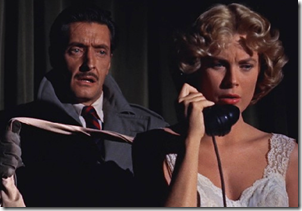The last time I saw Alfred Hitchcock’s Dial M for Murder on the big screen, or in 3D, was the first time any paying audience had seen it in decades. That was in 1980, at San Francisco’s York Theater. I finally experienced the film properly again Thursday night at the Rafael, and it’s a much better movie than I remembered.
That 1980 screening was on a double bill with the even-better Strangers on a Train. Oddly, Dial M feels in some ways like a sequel to Strangers. In the first film, Farley Granger plays a young tennis pro estranged from his philandering wife. The happy ending has him ready to marry the daughter of a rich and powerful man. In Dial M, Ray Milland plays a middle-aged former tennis pro with a wealthy, but philandering wife. Both stories involve a plot to murder the adulteress, with the dirty deed performed by a seemingly disinterested third party.
In Dial M for Murder, Grace Kelly plays that wife in her first of three performances for Hitchcock. Knowing of her infidelity, and wanting to inherit her fortune, Milland plans an  elaborate "perfect" murder, blackmailing and bribing an old acquaintance to commit the crime when the phone rings. Things don’t go as planned, but Milland is a bright fellow who can still turn things to his favor…maybe.
elaborate "perfect" murder, blackmailing and bribing an old acquaintance to commit the crime when the phone rings. Things don’t go as planned, but Milland is a bright fellow who can still turn things to his favor…maybe.
Set in England (but shot in Warner Brothers’ sound stages in Burbank), it’s all very droll. Everyone speaks calmly and wittily.
In fact, the film’s major weakness is the abundance of talking. Frederick Knott adopted his own stage play for the screen, and apparently didn’t change it much. Large chunks of the movie feel like theatre, with actors giving long, expository speeches. Hitchcock does what he can to liven these scenes with his patented, paranoia-producing camera angles, but the staginess still comes through.
But I don’t want to emphasize the film’s weaknesses. There were good reasons why the play was a Broadway hit, and why Warners picked Alfred Hitchcock to helm the film version. The story if filled with wit, suspense, and thrills. There’s great pleasure in watching Milland inwardly squirm as his plot unravels, then find a way to turn events in his favor, only to squirm inwardly again.
Hitchcock made Dial M for Murder in 1953, at the height of Hollywood’s first and very short 3D boom. Warner Brothers insisted he shoot the film stereoscopically. Hitchcock used the new format well by hardly using it at all. Most of the film is shot like a conventional, flat movie. But the one time Hitchcock throws something at the screen, you don’t laugh at the silly 3D hokum; you jump out of your seat and scream. That moment stands amongst Hitchcock’s greatest scenes, and it’s entirely dependent on 3D for its effect.
Warner Brothers recently restored the film digitally. Much of it looks very grainy–especially the exteriors (of which there are few). Presumably the source was several generations away from the negative. Or perhaps early Warnercolor really was that grainy.
The Rafael is showing the film digitally, which some people object to but not me. Realistically speaking, digital projection makes the 3D experience far more practical, and therefore more available to audiences.
You can catch it again at the Rafael on Sunday, at 4:15 and 7:00. I highly recommend it.
